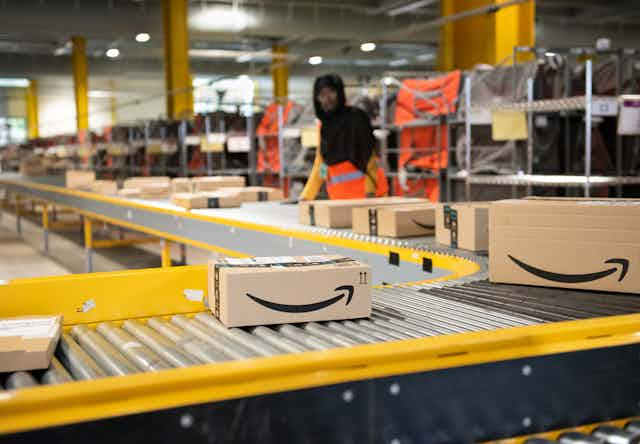A recent undercover investigation in an Amazon warehouse in Dunfermline, Scotland, reported the disposal of more than 130,000 “new or lightly used” objects in a single week in just that one location. Public outrage was clear. Questions were asked about how Amazon could be so wasteful and why weren’t the usable objects sent to those in need?
Amazon responded to the ITV investigation by saying it is “working towards a goal of zero product disposal”, and that “no items are sent to landfill in the UK”. UK business secretary Kwasi Kwarteng responded to the warehouse story with “surprise” implying that this waste was unexpected (both Amazon and the Scottish government have circular economy strategies designed to limit waste to landfill). The Amazon whistleblower behind the story claimed “there’s no rhyme or reason to what gets destroyed” suggesting this “surprise” waste was the consequence of a disorganised system.
But waste doesn’t just happen. Trash is the result of socio-cultural acts of classification in which objects are considered valueless within a particular context. Organisations classify objects within financial accounts. From an accounting perspective, the waste in the Amazon warehouse was neither disorganised nor unexpected but rather was a predictable consequence of accounting designed for a linear economy.
Most objects in financial accounts are classified as stock, a type of asset. Stocks depreciate in value over time, until ultimately – when cost of storage outweighs potential return – that unsold stock becomes a liability. Organisations can choose how to dispose of their liabilities but, in balance-book terms, the stock has become waste: worthless objects to be discarded (in the cheapest possible way).
Society is producing more waste every year and yet, for most of us, that waste remains out of sight. Most wealthy countries have designed waste management systems that remove perceived worthless objects from our economy quickly and cheaply.
The efficiency of these hidden waste management systems is reflected in financial accounts. Traditional waste infrastructure (landfill and materials recovery facilities) is accessible and reliable enough to still be the cheapest disposal option for many organisations, despite landfill taxes designed to encourage alternative paths for unwanted objects.

What makes the Amazon case particularly alarming is the volumes of waste involved (several million tonnes a year by some estimates). Importantly most of this waste is not from Amazon’s own retail business, but rather the unwanted stock from some of the thousands of smaller organisations that use Amazon as a retail platform and distributor. The waste generated by financial accounting is a systemic problem.
The low cost of landfill disposal is another example of the now well-recognised failure of financial accounts to capture negative environmental consequences. However, in the case of waste disposal, it is not necessarily that alternatives to landfill or recycling cost more. Rather, the associated costs (such as the markets for reuse) are unknown and so difficult to include within financial accounts.
Accounting in a circular economy
We should encourage a transition from a linear to more circular economy, in which resources are reused and the need for landfill largely eliminated. To do this, we must begin to understand the financial costs associated with recycling and reuse, how objects retain some value beyond an individual organisational context and how this value might be reported within accounts. We need to envisage a system of accounting for circularity.
Accounting for circularity will inevitably require organisations to produce social and environmental reports in addition to financial accounts, and a recognition that organisations cannot become circular on their own. Accounting in a circular economy requires collaborative accounts between organisations that transcend traditional boundaries and extend across supply chains to consider value in production and consumption systems.
Through these accounts we can begin to make waste visible, identify ecological limits to consumption and challenge those organisations and organisational practices that test those limits. In the case of Amazon, this might involve both the platform (Amazon) and its sellers collaborating on publicly available accounts that capture the material value of excess stock.
Efforts to account for the material flow within our production and consumption system are being pursued and Scotland, where I work and the Amazon warehouse is located, is leading the way. This week Zero Waste Scotland publicised its report which found that the total weight of resources used in 2017 by individual Scots (18.4 tonnes) was more than double predicted sustainable levels (8 tonnes). Work is still required to understand the contribution of organisational practices to this national material flow.
Scotland’s proposed Circular Economy Bill – including mandatory reporting of business waste – was put on hold indefinitely in light of the pandemic. However, the Amazon warehouse exposé reinforces that accounting for waste should be put back on the legislative agenda.

